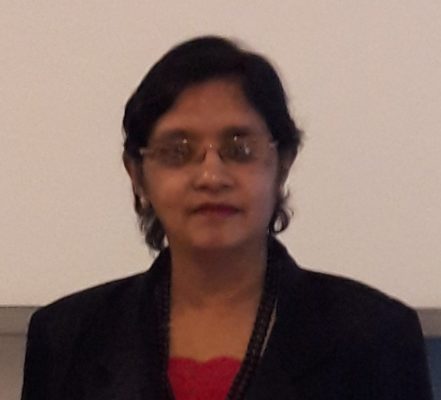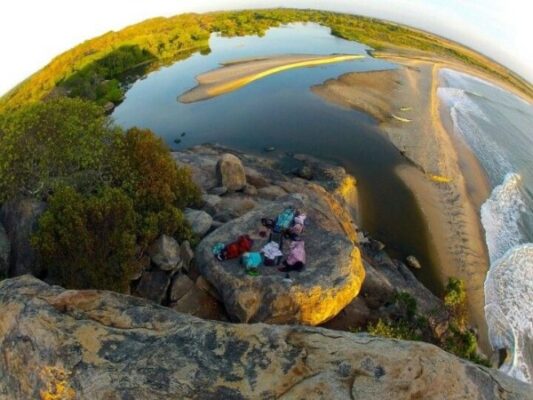Crocodile Rock – archaeological site in Arugam Bay
By Arundathie Abeysinghe
 Situated in Arugam Bay in East Coast of Sri Lanka, a surfers’ paradise, Crocodile Rock is also known as “Elephant Rock”, according to many tourists. The site is known as “Crocodile Rock” due to its elongated ‘snout’ shape. In reality, the name is derived due to mugger crocodiles that access this site via the adjoining Heda Oya (Oya meaning stream in Sinhala). At times, there are mugger crocodiles basking in the sun on Crocodile Rock. Situated around 320 kilometers east of Colombo adjacent to the Indian Ocean, Arugam Bay is one of the best surfing sites in the world.
Situated in Arugam Bay in East Coast of Sri Lanka, a surfers’ paradise, Crocodile Rock is also known as “Elephant Rock”, according to many tourists. The site is known as “Crocodile Rock” due to its elongated ‘snout’ shape. In reality, the name is derived due to mugger crocodiles that access this site via the adjoining Heda Oya (Oya meaning stream in Sinhala). At times, there are mugger crocodiles basking in the sun on Crocodile Rock. Situated around 320 kilometers east of Colombo adjacent to the Indian Ocean, Arugam Bay is one of the best surfing sites in the world.
Crocodile Rock is situated at the river mouth where Heda Oya falls to the sea, towards east of *Sastrawela Mani Naga Pabbatha Viharaya. The area of Crocodile Rock is a popular beginner as well as intermediate surfing site.

Crocodile Rock is known as an elusive surfing spot and less known to many than Arugam Bay, the internationally famous surfing spot. Unlike surfing points in Arugam Bay, especially suitable for expert surfers, surfing spots in Crocodile Rock offers surfers with moderately frequent point breaks with average waves which reach up to around 400 meters. Hence, Crocodile Rock is ideal for amateurs.
The best surfing period in this area is from July to August and the surfing season starts in May and concludes in September.
As Arugam Bay area is bordered by Yala National Park, some wildlife can be seen at Crocodile Rock too as the Rock is sandwiched between patches of jungle as well as the ocean. The rocky outcrop of the area offers visitors an area of wilderness as well as ideal waves.
Apart from surfing, there are national parks, some drip ledge caves, rock cut steps as well as historic temples in the area rarely visited by local as well as foreign tourists. The ruins in the area are declared as protected archaeological sites by the Government of Sri Lanka with a Gazette issued on October 10, 2014.
From the summit of Crocodile Rock, breathtaking views of the beach, the coast, the lagoon and the surrounding paddy fields can be seen well.
As there are no proper places of accommodation, Crocodile Rock is not a crowded place.
Directions: The route to Crocodile Rock is via the road to Sastrawela Mani Naga Pabbatha Viharaya in Panama in Arugam Bay. Crocodile Rock is situated along the coast.
- King Mahanaga – He was the first king of the *Kingdom of Ruhuna.
- Kingdom of Ruhuna – A center of flourishing culture and civilization as well as economic centers of ancient Sri Lanka, Kingdom of Ruhuna was found around 200 BC by Prince Mahanga, brother of King Devanampiyatissa of Anuradhapura Kingdom (247 BC to 207 BC) after fleeing Anuradhapura due to a family dispute. During ancient times, Ruhuna was the area identified mainly as the Southern Province, a large area of Uva Province (consisting of Badulla and Monaragala Districts) and some areas of Sabaragamuwa (consisting of Ratnapura and Kegalle Districts) and Eastern provinces (capital of Eastern Province is Trincomalee District).
- Poya Day – Poya is the name given to the Buddhist Full Moon Holiday known as “Uposatha” (Buddhist day of religious observance which was in existence from the Buddha’s period to date). There are 13 -14 Poya Days including Adhi (extra in Sinhala) Poya Day per annum. Adhi Poya Day is the second Poya Day of a month as in Adhi Vesak. In Sri Lanka Poya Day is declared as a Public, Bank and Mercantile Holiday.
- Sastrawela Mani Naga Pabbatha Viharaya – This is a temple situated in close proximity to Arugam Bay in the east coast of Sri Lanka. According to legends, many scholars from far away kingdoms in Sri Lanka as well as from India had traveled to this temple, to learn various disciplines of science and astrology. According to chronicles, this temple (viharaya in Sinhala) dates back to the period of *King Mahanaga, the first king of *Ruhuna. The Temple is almost in ruins and there is an incomplete stupa (dagoba) and a few scattered granite pillars. At present too, the Temple is venerated by Buddhists on *Poya Days.







